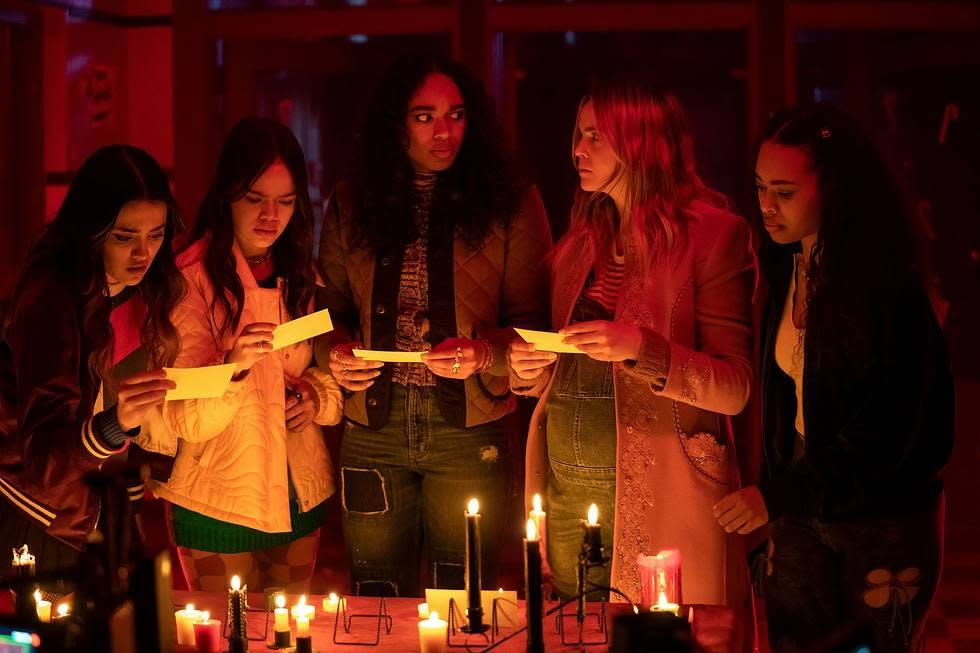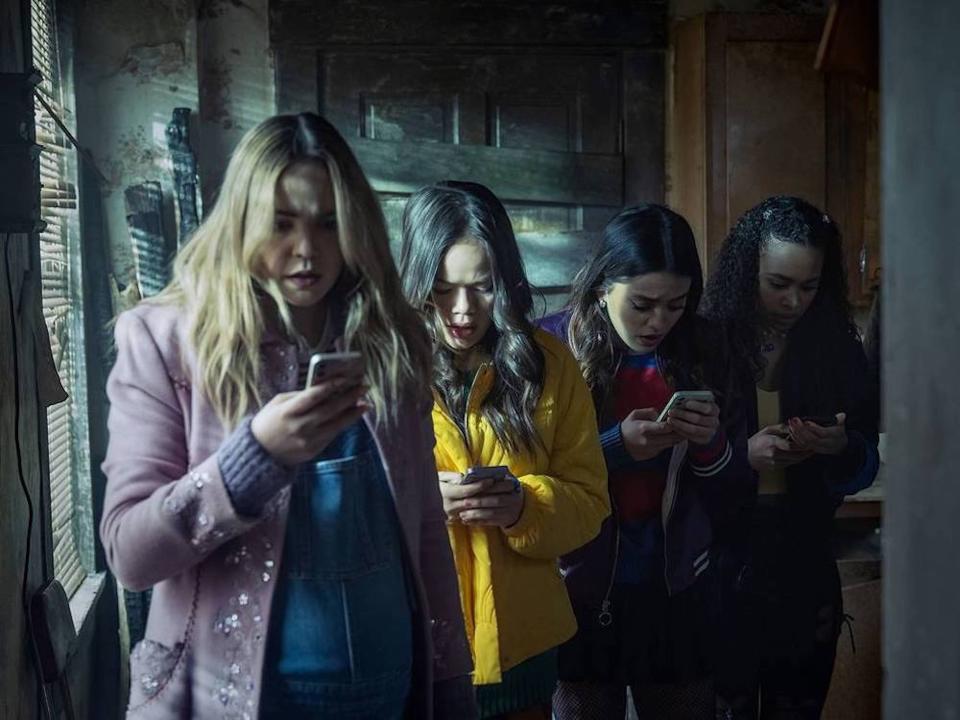How ‘Pretty Little Liars: Summer School’ Explored Religious Fanaticism

In 2022, Max resurrected the long running teen favorite “Pretty Little Liars” from the brains behind “Riverdale” and “Chilling Adventures of Sabrina,” Roberto Aguirre-Sacasa and Lindsay Calhoon Bring as “Pretty Little Liars: Original Sin.” Based on the books by Sara Shepard, the original followed four teenage girls in Rosewood, Pennsylvania who begin getting threatening messages years after their friend Alison disappears signed only with the initial “A.” Running for seven seasons beginning in 2010, “Pretty Little Liars” became a pop culture hit.
“Original Sin” is the the fourth series in the franchise and still set in that world, but this time around follows five friends in Millwood, Pennsylvania who are being stalked by “A” because of their mother’s involvement in the death of a classmate, Angela Waters, in 1999. While this serves as the main storyline, the friends also deal with serious issues like rape and suicide, as well as typical high school drama. What ensues is a highly entertaining remix of the original while taking a modern view of some of the tropes the ABC Family show didn’t fully explore. While “Pretty Little Liars” had a certain amount of terror in it, they never went full blown horror movie. Being able to work within the universe of PLL, Aguirre-Sacasa and Calhoon Bring have been able to take all the best elements of the PLL story and flip it on its head.
More from IndieWire
For “Original Sin,” the PLL books were ripe with inspiration for themes they wanted to explore like generational trauma and the gendered roles in horror. Films like “Carrie” and “Psycho” and 1999 teen dramas like “Popular” helped to build the stories of Imogen (Bailee Madison), Tabby (Chandler Kinney), Mouse (Malia Pyles), Faran (Zaria), and Noa (Maia Reficco) as they were hunted by and hunted A with Season 1 ending with Imogen and Tabby finding out their rapist was nice guy Chip (Carson Rowland) and uncovering the identity of A—the twin brother, Archie, of Angela Waters. Post credits, of the episode titled “Final Girls,” it’s discovered that Archie has escaped and Chip is his prey.
The idea of a Final Girl, a longtime horror trope, was something that Season 2, now titled “Pretty Little Liars: Summer School,” which recently ended its season, explores with our group of girls. Things begin with them awaiting A’s trial, who was captured after his escape going on a killing spree including Chip. They are in therapy and self defense and are determined to have a hot girl summer. That’s not in the cards due to two things — the girls have to go to summer school because being hunted by a killer derailed their grades and in PLL tradition they begin hearing from another A — Bloody Rose Waters — the mother of Angela and Archie. A new website, Spooky Spaghetti, becomes a hit telling fictional and non-fictional stories about The Waters family.
When Aguirre-Sacasa and Calhoon Bring pitched Season 2 to Max, they always knew that Bloody Rose Waters would be the villain of the season. “The movie that we were in dialogue with the most this season was ‘Friday the 13th Part 2.’ We knew that Bloody Rose Waters was the villain. Of course, we knew that Bloody Rose Waters was kind of a bastardization, a mythical version of the real Archie Waters’ mother, but we weren’t sure who was going to be behind the mask,” Calhoon Bring told IndieWire.
The Friday the 13th franchise not only informed their villains — Season 1 their Jason (Archie Waters) is the villain and in Season 2 their Jason’s mother (Bloody Rose Waters) is, but it also informed their summer setting, putting the girls in summer school and summer jobs and using those daylight settings to inform the horror of the show. The pizza shop where Noa works and the movie theater where film lover Tabby works were established in Season 1. So the new places like Faran’s job as a lifeguard makes the local pool a hotspot for the group, but also explores sexism as the sole girl working with a bunch of boys. And Imogen’s job at an ice cream store gives a new, and cold, environment, along with a sexy new co-worker and love interest.
While the show is a ray of sunshine, due to last year’s WGA and SAG strikes, the last two episodes of Season 2 weren’t filmed during the summer with the rest of the episodes. “We were so excited about shooting in the summer, but given the strikes, a lot of our last two episodes, all of our night exteriors were shot in the dead of winter. Our production team had to literally make a dead of winter forest seem like summer. We loved the summer trope and all the stuff at the pool. It just gave it a very different feel. But the irony is, when all was said and done, we were shooting at the end of December, freezing and bundled up,” Aguirre-Sacasa said.

Another hallmark of horror, religious fanaticism, Aguirre-Sacasa and Calhoon Bring got to explore after planting the seeds last season with Kelly Beasley (Mallory Bechtel) and her mother Martha (Jennifer Ferrin) who after losing Kelly’s twin sister Karen and father and husband Sheriff Tom Beasley in Season 1 turn to a local church, Our Mother of Holy Grace, to process their grief. Aguirre-Sacasa was inspired by growing up outside of D.C. and during the summers there would be county fairs he would go to where fundamentalist church volunteers would post up at to hand out fliers about their churches. Things aren’t as they seem with the church and Kelly and her mother get involved in some creepy stuff including a hell house, which is a haunted house run by evangelical Protestant churches designed to depict acts that they see as sinful.
The hell house idea came up in Season 1, but they knew they wanted to devote more time to is citing films like “Children of the Corn” as inspiration for Season 2. “One of our writers pitched a hell house themed episode for Season 1. And we thought, ‘That’s bigger than just an episode that could be a full season arc.’ So we saved it for season two. Then when we were doing a summer season, we love things like summer theater camp. And it’s like, what’s the horror movie version of a summer theater camp story? And it was like, ‘Religious fanatics,’” Aguirre-Sacasa said.
Episode 6, “Hell House,” ends up being one of the best and most impactful episodes of the series. The girls fight to bring the hell house down which is also being hosted at Imogen’s late mother’s house who committed suicide. At first thought, a hell house themed episode doesn’t seem like the natural fit for a Pride episode but the fight against the hell house is based in the incredibly queer fabric of the show. This season, Noa’s bisexuality is explored, and her feelings for both her longtime boyfriend and a girl she spent time with in juvie. And PLL’s power couple is Mouse and her boyfriend, Ash (Jordan Gonzalez), a transgender man, who got together in Season 1 and it’s never treated as anything other than normal.
The combination of the Hell House and Ash’s rejection to host a Pride event in Milwood brings the girls together to host their own Pride event at Faran’s pool which is incredibly joyful and moving, especially as Noa comes out to her friends. (Plus, there’s a great “Riverdale” Easter egg for fans). Making sure the episode balanced the light and the dark was very important.
“When we talked about a hell house episode, even in season one, we knew how traumatizing and dark those were. We thought that there’s a really great way to tell this story, but there has to be some light and joy in this. And to show there is a light at the end of the very dark tunnel. It was important for us to show Mouse and Ash so happy and so in love and so galvanized by everything. It was so important for us for Noa to really come out to her friends as bi,” Calhoon Bring noted.
A show that’s so inclusive and righting some of the wrongs of the original show (too many creepy older men dating teenagers), is great at putting well worn tropes on their heads. While this season explored all the girls as Final Girls, Tabby, a Black horror fan and director, was the last standing in a tradition that normally lets its Black characters down. The throughline of the season critiques whiteness in many different ways, through the church, the ways in which people of color are blamed, and white men seeing inclusion as a means of gatekeeping.
Much of this is explored through Wes (Derek Klena), Tabby’s older boss at the movie theater and a fellow film enthusiast and hopeful director. In Season 1, Wes’s creepiness is verified as he lurks on Tabby romantically. So the Season 2 reveal, making Wes one half of the pseudo Archie Waters and Bloody Rose Waters killer tag team was able to explore just that, even if Aguirre-Sacasa and Calhoon Bring hadn’t originally planned it that way. They knew they wanted Tabby as the ultimate Final Girl this season, having known they wanted the image of her with a pitchfork early on.
So the question became who would be close to Tabby who would make sense — Mrs. Langsberry (Carey Van Driest), Chip’s mother who knew her when they were friends, now blames Tabby for his death and believes that she’s lying about him raping her. And they knew that Wes would blame Tabby for his lack of success as her short films get attention. Bringing Wes onboard also helped to make more narrative sense as opposed to just having Mrs. Langsberry as the killer due to the Spooky Spaghetti of the season, knowing that the tech portion of recruiting teenagers into their narrative would likely have someone younger behind it.
“We’re in this industry and it’s a tough industry, and I know those guys who say, “Oh, this is the reason why I haven’t made it’ because people are focusing on being inclusive,” Calhoon Bring said. “When we landed on Wes, we were looking at what are the things that would make Wes truly [snap] and we’ve known Wes from last season that he’s this guy whose claim to fame is he went to NYU, he drops it all the time. He makes movies that we’ve never seen, but he talks about them as if he’s Francis Ford Coppola. We’re not seeing him write movies like Tabby’s doing.”
Calhoon Bring continued: “He’s angry at the world and angry at Tabby, especially seeing a young Black woman who’s super talented and has a super bright future ahead of her and he’s looking at her as if she represents the things that he doesn’t have. We thought that while that’s very grounded and insane, it works really well in a heightened horror story between the two characters. We’re definitely in dialogue with this sort of unhinged ideology for sure.”
Now that the Season 2 finale has aired, Aguirre-Sacasa and Calhoon Bring are hoping for a Season 3, as the first two seasons have shown that you can make a wildly entertaining and fun horror show that can also have incise social commentary and breaking and modernizing tropes that should have been flipped ages ago.
Best of IndieWire
The Best Father and Son Films: 'The Tree of Life,' 'The Lion King,' 'Nowhere Special,' and More
The 51 Best Sexy Movies of the 21st Century, from 'Spring Breakers' to 'X'
The 14 Best Thrillers Streaming on Netflix in June, from 'Fair Play' to 'Emily the Criminal'
Sign up for Indiewire's Newsletter. For the latest news, follow us on Facebook, Twitter, and Instagram.


